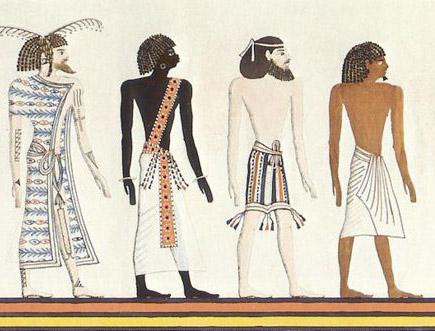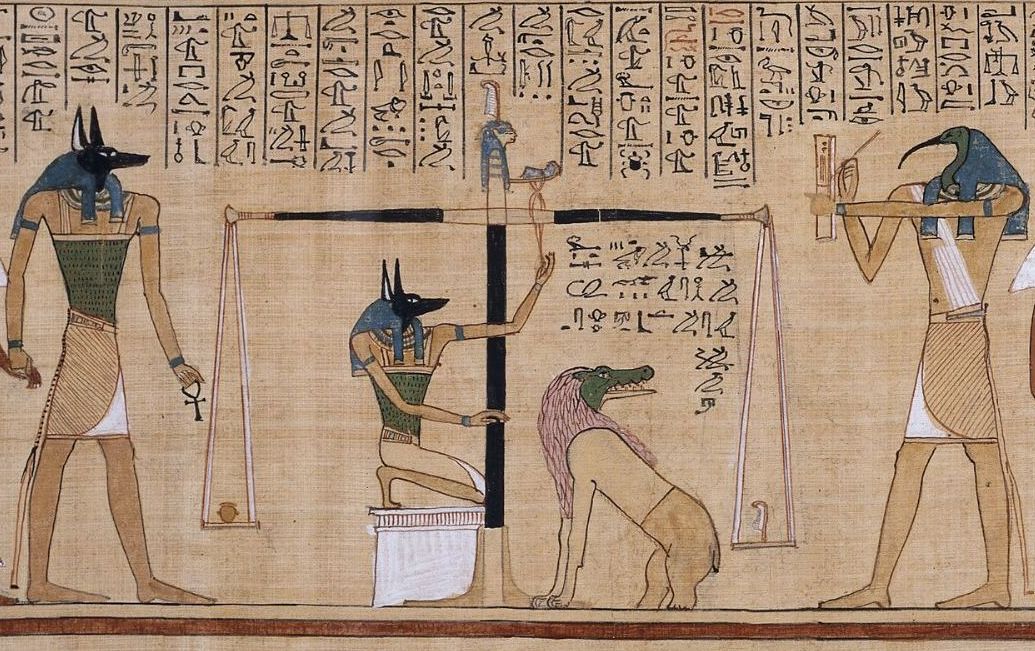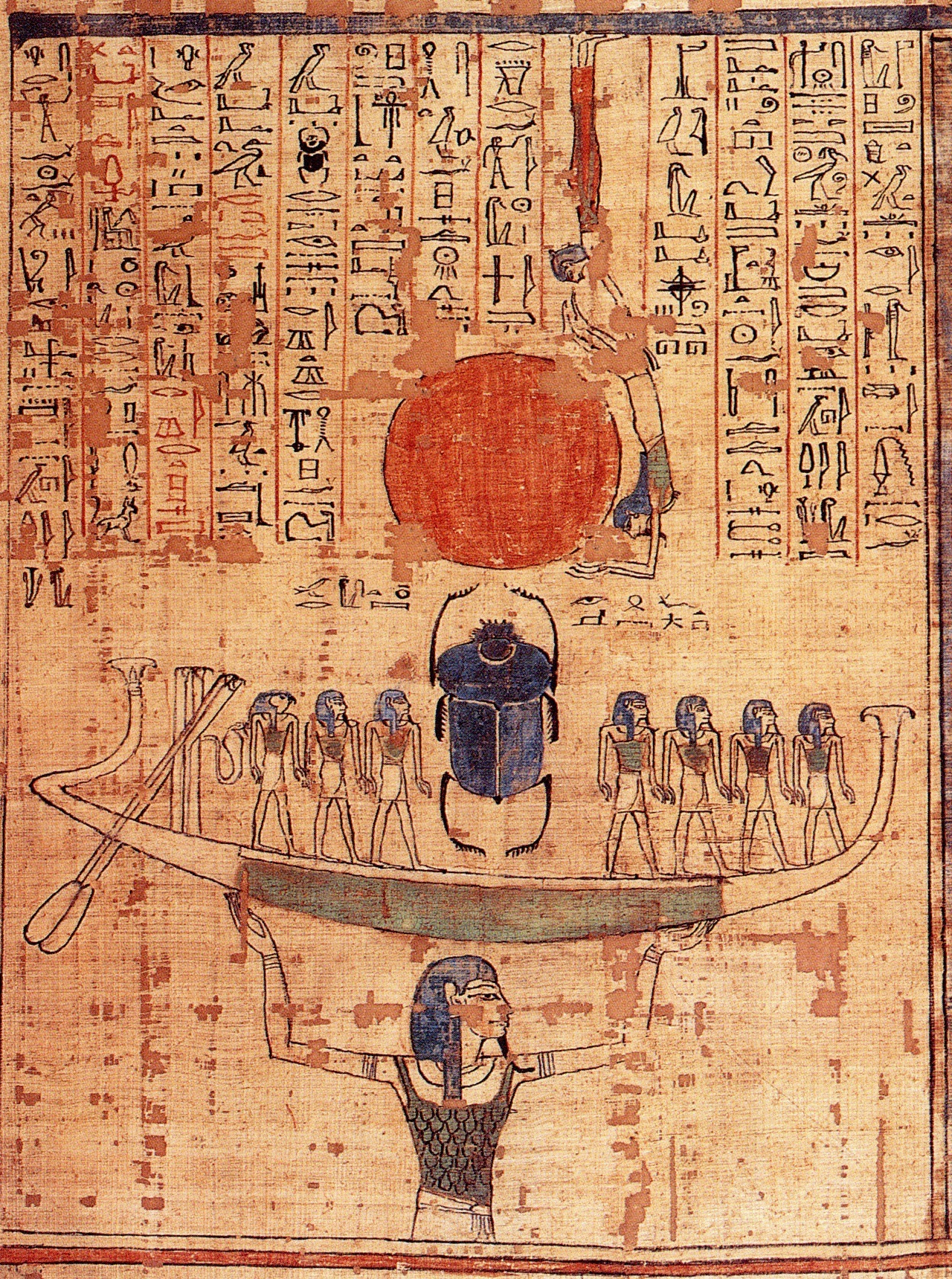|
Book Of Gates
The Book of Gates is an ancient Egyptian funerary text dating from the New Kingdom. It narrates the passage of a newly deceased soul into the next world, corresponding to the journey of the sun through the underworld during the hours of the night. The soul is required to pass through a series of 'gates' at different stages in the journey. Each gate is associated with a different goddess, and requires that the deceased recognise the particular character of that deity. The text implies that some people will pass through unharmed, but that others will suffer torment in a lake of fire. Categories The most famous part of the ''Book of Gates'' today refers to the different races of humanity known to the Egyptians, dividing them up into four categories that are now conventionally labelled "Reth" (Egyptians), "Aamu" ( Asiatics), "Nehesu" (Nubians), and "Themehu" ( Libyans). These are depicted in procession entering the next world. The text and images associated with the Book of Gate ... [...More Info...] [...Related Items...] OR: [Wikipedia] [Google] [Baidu] |
Ancient Egyptian Funerary Texts
The literature that makes up the ancient Egyptian funerary texts is a collection of religious documents that were used in ancient Egypt, usually to help the spirit of the concerned person to be preserved in the afterlife. They evolved over time, beginning with the Pyramid Texts in the Old Kingdom through the Coffin Texts of the Middle Kingdom and into several books, most famously the Book of the Dead, in the New Kingdom and later times. Old Kingdom The funerary texts of the Old Kingdom were initially reserved for the king only. Towards the end of the period, the texts appeared in the tombs of royal wives. Middle Kingdom These are a collection of ancient Egyptian funerary spells written on coffins beginning in the First Intermediate Period. Nearly half of the spells in the Coffin Texts derive from those in the Pyramid Texts. New Kingdom *Book of the Dead *Amduat *Spell of the Twelve Caves * The Book of Gates *Book of the Netherworld *Book of Caverns * Book of the Earth *Litany ... [...More Info...] [...Related Items...] OR: [Wikipedia] [Google] [Baidu] |
Nubians
Nubians () (Nobiin: ''Nobī,'' ) are an ethnic group indigenous to the region which is now northern Sudan and southern Egypt. They originate from the early inhabitants of the central Nile valley, believed to be one of the earliest cradles of civilization. In the southern valley of Egypt, Nubians differ culturally and ethnically from other Egyptians, although they intermarried with members of other ethnic groups, especially Arabs. They speak Nubian languages as a mother tongue, part of the Northern Eastern Sudanic languages, and Arabic as a second language. Early Neolithic settlements have been found in the central Nubian region dating back to 7000 BC, with Wadi Halfa believed to be the oldest settlement in the central Nile valley. Parts of Nubia, particularly Lower Nubia, were at times a part of ancient Pharaonic Egypt and at other times a rival state representing parts of Meroë or the Kingdom of Kush. By the Twenty-fifth Dynasty (744 BC–656 BC), all of Egypt was united wit ... [...More Info...] [...Related Items...] OR: [Wikipedia] [Google] [Baidu] |
Book Of The Dead
The ''Book of the Dead'' ( egy, 𓂋𓏤𓈒𓈒𓈒𓏌𓏤𓉐𓂋𓏏𓂻𓅓𓉔𓂋𓅱𓇳𓏤, ''rw n(y)w prt m hrw(w)'') is an ancient Egyptian funerary text generally written on papyrus and used from the beginning of the New Kingdom (around 1550 BCE) to around 50 BCE. The original Egyptian name for the text, transliterated ''rw nw prt m hrw'', is translated as ''Book of Coming Forth by Day'' or ''Book of Emerging Forth into the Light''. "Book" is the closest term to describe the loose collection of texts consisting of a number of magic spells intended to assist a dead person's journey through the ''Duat'', or underworld, and into the afterlife and written by many priests over a period of about 1,000 years. Karl Richard Lepsius introduced for these texts the German name ''Todtenbuch'' (modern spelling ''Totenbuch''), translated to English as Book of the Dead. The ''Book of the Dead'', which was placed in the coffin or burial chamber of the deceased, was part of a trad ... [...More Info...] [...Related Items...] OR: [Wikipedia] [Google] [Baidu] |
Egyptian Mythology
Egyptian mythology is the collection of myths from ancient Egypt, which describe the actions of the Egyptian gods as a means of understanding the world around them. The beliefs that these myths express are an important part of ancient Egyptian religion. Myths appear frequently in Egyptian writings and art, particularly in short stories and in religious material such as hymns, ritual texts, funerary texts, and temple decoration. These sources rarely contain a complete account of a myth and often describe only brief fragments. Inspired by the cycles of nature, the Egyptians saw time in the present as a series of recurring patterns, whereas the earliest periods of time were linear. Myths are set in these earliest times, and myth sets the pattern for the cycles of the present. Present events repeat the events of myth, and in doing so renew ''maat'', the fundamental order of the universe. Amongst the most important episodes from the mythic past are the creation myths, in which the ... [...More Info...] [...Related Items...] OR: [Wikipedia] [Google] [Baidu] |
Deir El-Medina
Deir el-Medina ( arz, دير المدينة), or Dayr al-Madīnah, is an ancient Egyptian workmen's village which was home to the artisans who worked on the tombs in the Valley of the Kings during the 18th to 20th Dynasties of the New Kingdom of Egypt (ca. 1550–1080 BCE)Oakes, p. 110 The settlement's ancient name was ''wikt:st#Etymology 2 2, Set wikt:mꜣꜥt#Egyptian, maat'' ("Place of Truth"), and the workmen who lived there were called "Servants in the Place of Truth". During the Christian era, the temple of Hathor was converted into a church from which the Egyptian Arabic name ''Deir el-Medina'' ("Monastery of the City") is derived. At the time when the world's press was concentrating on Howard Carter's discovery of the Tomb of Tutankhamun in 1922, a team led by Bernard Bruyère began to excavate the site."Pharaoh’s Workers: How the Israelites Lived in Egypt", Leonard and Barbara Lesko, Biblical Archaeological Review, Jan/Feb 1999 This work has resulted in one of the ... [...More Info...] [...Related Items...] OR: [Wikipedia] [Google] [Baidu] |
Sennedjem
Sennedjem was an Ancient Egyptian artisan. Sennedjem lived in Set Maat (translated as "The Place of Truth"), contemporary Deir el-Medina, on the west bank of the Nile, opposite Thebes, during the reigns of Seti I and Ramesses II. Sennedjem had the title "Servant in the Place of Truth". He was buried along with his wife, Iyneferti, and family in a tomb in the village necropolis. His tomb was discovered January 31, 1886. When Sennedjem's tomb was found, in it there was regular furniture from his home, including a stool and a bed, which he actually used when he was alive. His titles included Servant in the Place of Truth, Ushabti of Sennedjem from The Fine Arts Museums of San Francisco meaning that he worked on the excavation and decoration of the nearby royal tombs. See also *TT1 The Theban Tomb TT1 is located in Deir el-Medina, part of the Theban Necropolis, on the west bank of the Nile, opposite to Luxor. It is the burial place of the ancient Egyptian official, Sennedjem a ... [...More Info...] [...Related Items...] OR: [Wikipedia] [Google] [Baidu] |
Ramesses VII
Usermaatre Setepenre Meryamun Ramesses VII (also written Ramses and Rameses) was the sixth pharaoh of the 20th Dynasty of Ancient Egypt. He reigned from about 1136 to 1129 BC and was the son of Ramesses VI. Other dates for his reign are 1138–1131 BC. The Turin Accounting Papyrus 1907+1908 is dated to Year 7 III Shemu day 26 of his reign and has been reconstructed to show that 11 full years passed from Year 5 of Ramesses VI to Year 7 of his reign. Reign length Ramesses VII's seventh year is also attested in Ostraca O. Strasbourg h 84, which is dated to II Shemu day 16 of his 7th Regnal Year. In 1980, C.J. Eyre demonstrated that a Year 8 papyrus belonged to the reign of Ramesses VII. This papyrus, P. Turin Cat. 1883 + 2095, dated to ''Year 8 IV Shemu day 25'' (most likely Ramesses VII), details the record of the commissioning of some copper work and mentions two foremen at Deir El-Medina: Nekhemmut and Hor ose The foreman Hormose was previously attested in office only d ... [...More Info...] [...Related Items...] OR: [Wikipedia] [Google] [Baidu] |
Horemheb
Horemheb, also spelled Horemhab or Haremhab ( egy, ḥr-m-ḥb, meaning "Horus is in Jubilation") was the last pharaoh of the Eighteenth dynasty of Egypt, 18th Dynasty of Egypt (1550–1295 BC). He ruled for at least 14 years between 1319 BC and 1292 BC. He had no relation to the preceding royal family other than by marriage to Mutnedjmet, who is thought (though disputed) to have been the daughter of his predecessor Ay (pharaoh), Ay; he is believed to have been of common birth. Before he became pharaoh, Horemheb was the commander in chief of the army under the reigns of Tutankhamun and Ay (pharaoh), Ay. After his accession to the throne, he reformed the Egyptian state and it was under his reign that official action against the preceding Amarna Period, Amarna rulers began. Due to this, he is considered the ruler who restabilized his country after the troublesome and divisive Amarna Period. Horemheb demolished monuments of Akhenaten, reusing the rubble in his own ... [...More Info...] [...Related Items...] OR: [Wikipedia] [Google] [Baidu] |
Optical Character Recognition
Optical character recognition or optical character reader (OCR) is the electronic or mechanical conversion of images of typed, handwritten or printed text into machine-encoded text, whether from a scanned document, a photo of a document, a scene-photo (for example the text on signs and billboards in a landscape photo) or from subtitle text superimposed on an image (for example: from a television broadcast). Widely used as a form of data entry from printed paper data records – whether passport documents, invoices, bank statements, computerized receipts, business cards, mail, printouts of static-data, or any suitable documentation – it is a common method of digitizing printed texts so that they can be electronically edited, searched, stored more compactly, displayed on-line, and used in machine processes such as cognitive computing, machine translation, (extracted) text-to-speech, key data and text mining. OCR is a field of research in pattern recognition, artificial intellig ... [...More Info...] [...Related Items...] OR: [Wikipedia] [Google] [Baidu] |
Ancient Libya
The Latin name ''Libya'' (from Greek Λιβύη: ''Libyē'', which came from Berber: ''Libu'') referred to North Africa during the Iron Age and Classical Antiquity. Berbers occupied the area for thousands of years before the recording of history in ancient Egypt. Climate changes affected the locations of the settlements. More narrowly, ''Libya'' could also refer to the country immediately west of Egypt, viz Marmarica (''Libya Inferior'') and Cyrenaica (''Libya Superior''). The Libyan Sea or ''Mare Libycum'' was the part of the Mediterranean Sea south of Crete, between Cyrene and Alexandria. In the Hellenistic period, the Berbers were known collectively as ''Libyans'', a Greek term for the inhabitants of the Berber world. Their lands were called "Libya" and referred to the known African continent at that time, excluding Sub-Saharan Africa which was known as Aethiopia. Egypt contains the Siwa Oasis, which was part of ancient Libya. The Siwi language, a Berber language, is stil ... [...More Info...] [...Related Items...] OR: [Wikipedia] [Google] [Baidu] |
Levant
The Levant () is an approximate historical geographical term referring to a large area in the Eastern Mediterranean region of Western Asia. In its narrowest sense, which is in use today in archaeology and other cultural contexts, it is equivalent to a stretch of land bordering the Mediterranean in South-western Asia,Gasiorowski, Mark (2016). ''The Government and Politics of the Middle East and North Africa''. }, ), meaning "the eastern place, where the Sun rises". In the 13th and 14th centuries, the term ''levante'' was used for Italian maritime commerce in the Eastern Mediterranean, including Greece, Anatolia, Syria-Palestine, and Egypt, that is, the lands east of Venice. Eventually the term was restricted to the Muslim countries of Syria-Palestine and Egypt. In 1581, England set up the Levant Company to monopolize commerce with the Ottoman Empire. The name ''Levant States'' was used to refer to the French mandate over Syria and Lebanon after World War I. This is probab ... [...More Info...] [...Related Items...] OR: [Wikipedia] [Google] [Baidu] |
New Kingdom
New is an adjective referring to something recently made, discovered, or created. New or NEW may refer to: Music * New, singer of K-pop group The Boyz Albums and EPs * ''New'' (album), by Paul McCartney, 2013 * ''New'' (EP), by Regurgitator, 1995 Songs * "New" (Daya song), 2017 * "New" (Paul McCartney song), 2013 * "New" (No Doubt song), 1999 *"new", by Loona from '' Yves'', 2017 *"The New", by Interpol from ''Turn On the Bright Lights'', 2002 Acronyms * Net economic welfare, a proposed macroeconomic indicator * Net explosive weight, also known as net explosive quantity * Network of enlightened Women, a conservative university women's organization * Next Entertainment World, a South Korean film distribution company Identification codes * Nepal Bhasa language ISO 639 language code * New Century Financial Corporation (NYSE stock abbreviation) * Northeast Wrestling, a professional wrestling promotion in the northeastern United States Transport * New Orleans Lakefront Ai ... [...More Info...] [...Related Items...] OR: [Wikipedia] [Google] [Baidu] |





.png)